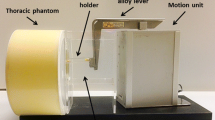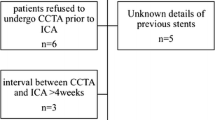Abstract
Purpose
To evaluate the impact of noise-optimized virtual monochromatic imaging (VMI+) on stent visualization and accuracy for in-stent re-stenosis at lower extremity dual-energy CT angiography (DE-CTA).
Material and methods
We evaluated third-generation dual-source DE-CTA studies in 31 patients with prior stent placement. Images were reconstructed with linear blending (F_0.5) and VMI+ at 40–150 keV. In-stent luminal diameter was measured and contrast-to-noise ratio (CNR) calculated. Diagnostic confidence was determined using a five-point scale. In 21 patients with invasive catheter angiography, accuracy for significant re-stenosis (≥50 %) was assessed at F_0.5 and 80 keV-VMI+ chosen as the optimal energy level based on image-quality analysis.
Results
At CTA, 45 stents were present. DSA was available for 28 stents whereas 12 stents showed significant re-stenosis. CNR was significantly higher with ≤80 keV-VMI+ (17.9 ± 6.4–33.7 ± 12.3) compared to F_0.5 (16.9 ± 4.8; all p < 0.0463); luminal stent diameters were increased at ≥70 keV (5.41 ± 1.8–5.92 ± 1.7 vs. 5.27 ± 1.8, all p < 0.001) and diagnostic confidence was highest at 70–80 keV-VMI+ (4.90 ± 0.48–4.88 ± 0.63 vs. 4.60 ± 0.66, p = 0.001, 0.0042). Sensitivity, negative predictive value and accuracy for re-stenosis were higher with 80 keV-VMI+ (100, 100, 96.4 %) than F_0.5 (90.9, 94.1, 89.3 %).
Conclusion
80 keV-VMI+ improves image quality, diagnostic confidence and accuracy for stent evaluation at lower extremity DE-CTA.
Key Points
• The impact of noise-optimized virtual monochromatic imaging on stent visualization was assessed.
• Virtual monochromatic imaging significantly improves stent lumen visualization and diagnostic confidence.
• At 80 keV diagnostic performance for detection of in-stent restenosis was increased.
• 80 keV virtual monochromatic images are recommended for stent evaluation of lower extremity vasculature.




Similar content being viewed by others
Abbreviations
- CNR:
-
Contrast-to-noise ratio
- CTA:
-
CT angiography
- CTDI:
-
CT dose index
- DECT:
-
Dual-energy CT
- DE-CTA:
-
Dual-energy CT angiography
- DLP:
-
Dose-length product
- DSA:
-
Digital subtraction angiography
- DSCT:
-
Dual-source CT
- F_0.5:
-
Linearly-blended images
- HU:
-
Hounsfield Units
- keV:
-
kilo-electron Volt
- NPV:
-
Negative predictive value
- PPV:
-
Positive predictive value
- ROI:
-
Region of interest
- SD:
-
Standard deviation
- SNR:
-
Signal-to-noise ratio
- VMI:
-
Virtual monochromatic imaging
- VMI+:
-
Noise-optimized virtual monochromatic imaging
References
Heijenbrok-Kal MH, Kock MC, Hunink MG (2007) Lower extremity arterial disease: multidetector CT angiography meta-analysis. Radiology 245:433–439
Kock MC, Adriaensen ME, Pattynama PM et al (2005) DSA versus multi-detector row CT angiography in peripheral arterial disease: randomized controlled trial. Radiology 237:727–737
Portugaller HR, Schoellnast H, Hausegger KA, Tiesenhausen K, Amann W, Berghold A (2004) Multislice spiral CT angiography in peripheral arterial occlusive disease: a valuable tool in detecting significant arterial lumen narrowing? Eur Radiol 14:1681–1687
Schernthaner R, Stadler A, Lomoschitz F et al (2008) Multidetector CT angiography in the assessment of peripheral arterial occlusive disease: accuracy in detecting the severity, number, and length of stenoses. Eur Radiol 18:665–671
Geyer LL, Glenn GR, De Cecco CN et al (2015) CT evaluation of small-diameter coronary artery stents: effect of an integrated circuit detector with iterative reconstruction. Radiology 276:706–714
Stehli J, Fuchs TA, Singer A et al (2015) First experience with single-source, dual-energy CCTA for monochromatic stent imaging. Eur Heart J Cardiovasc Imaging 16:507–512
Maintz D, Burg MC, Seifarth H et al (2009) Update on multidetector coronary CT angiography of coronary stents: in vitro evaluation of 29 different stent types with dual-source CT. Eur Radiol 19:42–49
Gassenmaier T, Petri N, Allmendinger T et al (2014) Next generation coronary CT angiography: in vitro evaluation of 27 coronary stents. Eur Radiol 24:2953–2961
Ulrich A, Burg MC, Raupach R et al (2015) Coronary stent imaging with dual-source CT: assessment of lumen visibility using different convolution kernels and postprocessing filters. Acta Radiol 56:42–50
von Spiczak J, Morsbach F, Winklhofer S et al (2013) Coronary artery stent imaging with CT using an integrated electronics detector and iterative reconstructions: first in vitro experience. J Cardiovasc Comput Tomogr 7:215–222
Eisentopf J, Achenbach S, Ulzheimer S et al (2013) Low-dose dual-source CT angiography with iterative reconstruction for coronary artery stent evaluation. JACC Cardiovasc Imaging 6:458–465
Zhou Q, Jiang B, Dong F, Huang P, Liu H, Zhang M (2014) Computed tomography coronary stent imaging with iterative reconstruction: a trade-off study between medium kernel and sharp kernel. J Comput Assist Tomogr 38:604–612
Ebersberger U, Tricarico F, Schoepf UJ et al (2013) CT evaluation of coronary artery stents with iterative image reconstruction: improvements in image quality and potential for radiation dose reduction. Eur Radiol 23:125–132
Almutairi A, Sun Z, Al Safran Z, Poovathumkadavi A, Albader S, Ifdailat H (2015) Optimal scanning protocols for dual-energy CT angiography in peripheral arterial stents: an in vitro phantom study. Int J Mol Sci 16:11531–11549
Cui X, Li T, Li X, Zhou W (2015) High-definition computed tomography for coronary artery stents imaging: initial evaluation of the optimal reconstruction algorithm. Eur J Radiol 84:834–839
Renker M, Ramachandra A, Schoepf UJ et al (2011) Iterative image reconstruction techniques: applications for cardiac CT. J Cardiovasc Comput Tomogr 5:225–230
Mangold S CP, Schoepf UJ, Wichmann JL, Canstein C, Fuller SR, Muscogiuri G, Varga-Szemes A, Nikolaou K, De Cecco CN (2015) Impact of an advanced image-based monoenergetic reconstruction algorithm on coronary stent visualization using 3rd generation dual-source dual-energy CT: a phantom study. Eur Radiol
Krauss B, Grant KL, Schmidt BT, Flohr TG (2015) The importance of spectral separation: an assessment of dual-energy spectral separation for quantitative ability and dose efficiency. Investig Radiol 50:114–118
Meyer M, Haubenreisser H, Schoepf UJ et al (2014) Closing in on the K edge: coronary CT angiography at 100, 80, and 70 kV-initial comparison of a second- versus a third-generation dual-source CT system. Radiology 273:373–382
Grant KL, Flohr TG, Krauss B, Sedlmair M, Thomas C, Schmidt B (2014) Assessment of an advanced image-based technique to calculate virtual monoenergetic computed tomographic images from a dual-energy examination to improve contrast-to-noise ratio in examinations using iodinated contrast media. Investig Radiol 49:586–592
Wichmann JL, Arbaciauskaite R, Kerl JM et al (2014) Evaluation of monoenergetic late iodine enhancement dual-energy computed tomography for imaging of chronic myocardial infarction. Eur Radiol 24:1211–1218
Beeres M, Trommer J, Frellesen C et al (2015) Evaluation of different keV-settings in dual-energy CT angiography of the aorta using advanced image-based virtual monoenergetic imaging. Int J Cardiovasc Imaging
Sudarski S, Apfaltrer P, Nance JW Jr et al (2013) Optimization of keV-settings in abdominal and lower extremity dual-source dual-energy CT angiography determined with virtual monoenergetic imaging. Eur J Radiol 82:e574–e581
Wichmann JL, Gillott MR, De Cecco CN et al (2015) Dual-energy computed tomography angiography of the lower extremity runoff: impact of noise-optimized virtual monochromatic imaging on image quality and diagnostic accuracy. Invest Radiol
Willmann JK, Weishaupt D, Lachat M et al (2002) Electrocardiographically gated multi-detector row CT for assessment of valvular morphology and calcification in aortic stenosis. Radiology 225:120–128
Fuchs TA, Stehli J, Fiechter M et al (2013) First experience with monochromatic coronary computed tomography angiography from a 64-slice CT scanner with Gemstone Spectral Imaging (GSI). J Cardiovasc Comput Tomogr 7:25–31
Gilard M, Cornily JC, Pennec PY et al (2006) Assessment of coronary artery stents by 16 slice computed tomography. Heart 92:58–61
Carbone I, Francone M, Algeri E et al (2008) Non-invasive evaluation of coronary artery stent patency with retrospectively ECG-gated 64-slice CT angiography. Eur Radiol 18:234–243
Pflederer T, Marwan M, Renz A et al (2009) Noninvasive assessment of coronary in-stent restenosis by dual-source computed tomography. Am J Cardiol 103:812–817
Pugliese F, Weustink AC, Van Mieghem C et al (2008) Dual source coronary computed tomography angiography for detecting in-stent restenosis. Heart 94:848–854
Acknowledgments
The scientific guarantor of this publication is Prof. Dr. U. Joseph Schoepf. The authors of this manuscript declare relationships with the following companies: Dr. Schoepf is a consultant for and receives research support from Astellas, Bayer, Bracco, GE, Medrad, and Siemens. The other authors have no conflicts of interest to disclose. The authors state that this work has not received any funding. One of the authors has significant statistical expertise. Institutional Review Board approval was obtained. Written informed consent was waived by the Institutional Review Board.
Some study subjects or cohorts have been previously reported in Wichmann et al. (2016) Dual-Energy CT Angiography of the Lower Extremity Run-off: Impact of Noise-Optimized Virtual Monochromatic Imaging on Image Quality and Diagnostic Accuracy. Invest Radiol. 51(2): 139-46. Methodology: retrospective, cross-sectional study, performed at one institution.
Author information
Authors and Affiliations
Corresponding author
Rights and permissions
About this article
Cite this article
Mangold, S., De Cecco, C.N., Schoepf, U.J. et al. A noise-optimized virtual monochromatic reconstruction algorithm improves stent visualization and diagnostic accuracy for detection of in-stent re-stenosis in lower extremity run-off CT angiography. Eur Radiol 26, 4380–4389 (2016). https://doi.org/10.1007/s00330-016-4304-8
Received:
Revised:
Accepted:
Published:
Issue Date:
DOI: https://doi.org/10.1007/s00330-016-4304-8




